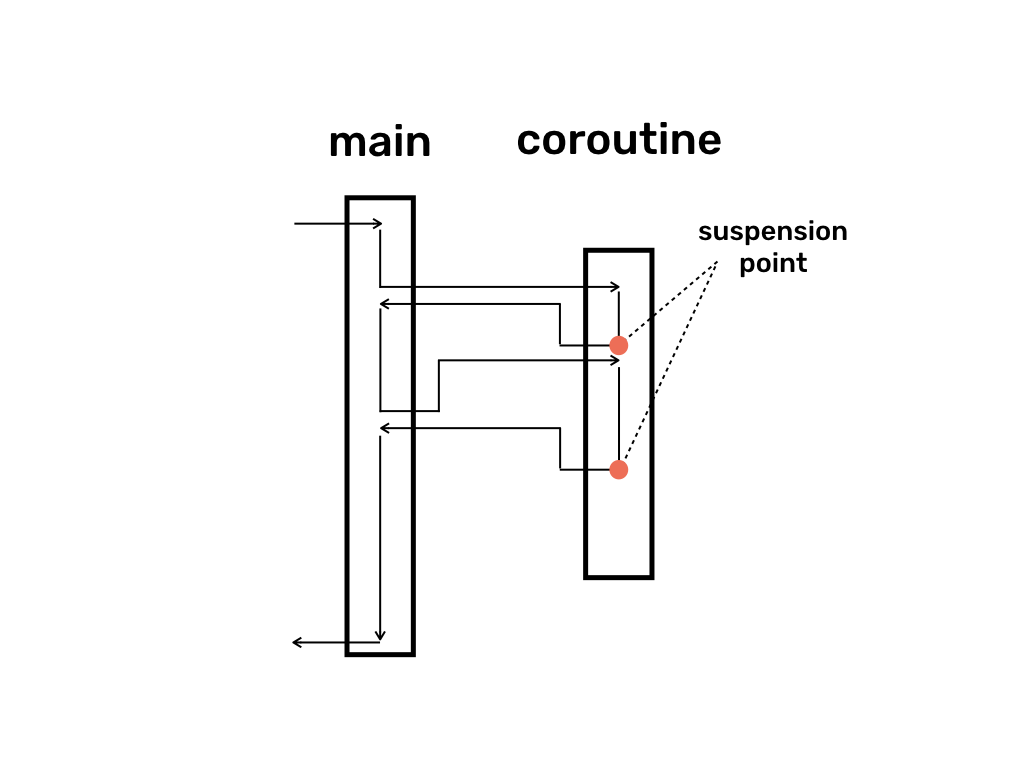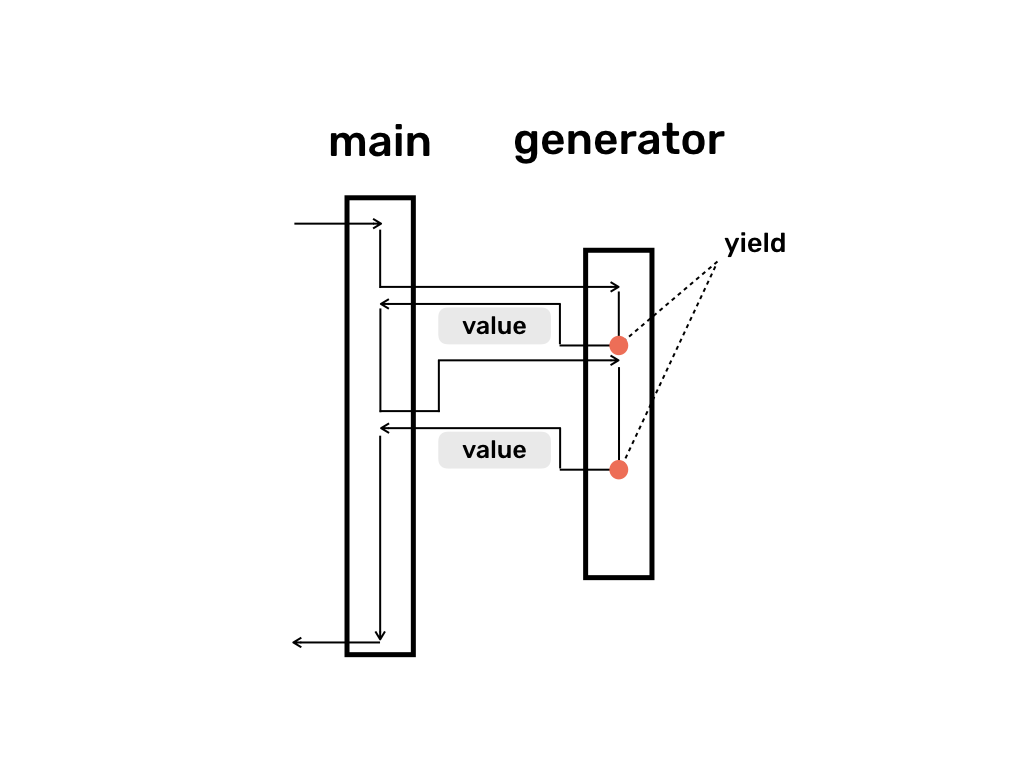Yielding Generators
This post is part of the blogpost series explaining coroutines, how they implemented in various programming languages and how they can make your life better:
The previous blogpost was about coroutines as threads which is probably the most intuitive coroutines implementation to use. However, there is another widespread and time-tested implementation based on generators using yield keyword and composable promises using async/await. This blog is about generators. They have been part of Python since 2001, C# since 2005 and JavaScript since 2015.
The following code examples will use JavaScript (to be precise ECMAScript 2017). There are few reasons: JavaScript coroutines implementation is quite typical; JavaScript is dynamically typed so it should be easier to understand examples without paying too much attention to types; JavaScript has C-like syntax so should look familiar for most developers.
Why use generators?
The main use-case for using generators is to define lazy computation with simpler syntax compared to writing an iterator manually (see example below). Sometimes whether the computation is lazy or not doesn’t matter, because it’s just easier to express with generators. In other cases, you really want laziness. This is often related to constrained resources or performance. For example, instead of reading a huge database table into memory a system could load data lazily as it’s being processed.
There are other uses for generators like simulating concurrency and using them as a base for implementing async/await but they are less common.
The most basic generator
Here is an example of the most basic generator:
In the code above we define a function called createGenerator. Note that createGenerator has * after the function keyword. This tells JavaScript that this function is a coroutine and we can use the yield keyword inside it. If function is not marked with *, then yield is illegal and will cause a runtime error in JavaScript or compilation error in compiled languages. Note the similarity to the previous blogpost where we couldn’t use Lua coroutine.yield() outside of coroutine created with coroutine.create. After creating the generator, we assign it to c and can use next() to start/resume execution of the coroutine. Each invocation of next() changes the state of the generator and returns an object which has a property called value through which we can access the data yielded by the generator. Overall, the program resumes coroutine three times and prints 123 never reaching the line with the monkey. To get the monkey printed we would need to add one more invocation of c.next().
Generators as threads
This might not be the first thing that comes up when you start using generators but there are a couple similarities between generators and coroutines as threads. The diagram below illustrates coroutines as threads in which coroutine yields execution back to main (you can find description of the notation in the previous blogpost).

And the diagram below shows a generator. As you can see they are pretty much identical. The main difference is that generators are predominantly used to return values back into the calling function. To be fair, coroutines as threads can also pass values to/from coroutine so technically there is not much difference. However, the difference is in the intent of the program. From this point of view it might be useful to think about different coroutine implementations as design patterns.

The main point here is that because the underlying idea is the same, we can use generators to do context switching similar to coroutines as threads:
Overall, the program keeps resuming coroutine c, which prints some value and yields execution back to main. It prints 12345 never reaching the line with the monkey. Note that we call yield without passing any value because in this example the main reason for using the generator is preemptive concurrency.
Generator state
Generators have a state which in JavaScript can be observed via an object returned by c.next(). In the example below, we create a generator which yields twice and in main we resume it three times printing the result of both next() and yield.
This program prints:
{ value: undefined, done: false }
undefined
{ value: undefined, done: false }
undefined
{ value: undefined, done: true }
Each call of next() returns an object with value and done attributes. While the generator hasn’t reached the last instruction, done attribute isfalse. When all the code in the generator is executed it ends up in the done: true state (similar to the state of a thread). All the values returned by next() are undefined because the generator didn’t send anything back to main. The two undefined lines are printed by console.log(yield), i.e. yield is evaluated to undefined because no values were passed into the c.next().
As mentioned before one of the main reasons to use generators is to return some values as shown in the following example:
This program prints:
{ value: '🐶', done: false }
B
{ value: '🐷', done: false }
C
{ value: undefined, done: true }
Here we create a generator which yields a dog and a pig. And in the main function we resume the generator by passing values to it. Note that the first value passed into c.next() is lost and the last value returned from generator when it finishes execution is undefined.
Stackless yield
JavaScript implementation of coroutines is stackless (this is also true for Python, C#, Kotlin). In particular, this means that coroutines cannot yield from sub-functions.
In the example below, we create a generator which yields a dog and then calls forEach on an array passing it an anonymous function it => { ... }. Since the anonymous function call still counts as a sub-function, we cannot yield from inside it. This example fails at runtime, but in a compiled language this would be a compilation error.
You might attempt to extract the anonymous function into a named function and mark it with * to make JavaScript happy. However, this won’t solve the problem because the new function will become a generator on its own and will not yield from the outer createGenerator() function.
function* f(it) {
console.log(yield it);
}
function* createGenerator() {
console.log(yield "🐶");
[1, 2, 3].forEach(it => f(it));
}
const c = createGenerator();
console.log(c.next("A"));
console.log(c.next("B"));
console.log(c.next("C"));
This program doesn’t fail at runtime but no numbers are printed:
{ value: '🐶', done: false }
B
{ value: undefined, done: true }
{ value: undefined, done: true }
In this particular case of yielding from for loop there is an easy way to fix the code by using array iteration syntax which doesn’t require anonymous functions. Obviously, this works because JavaScript has some knowledge of how to handle for loops containing yield expressions.
This works as expected and prints:
{ value: '🐶', done: false }
B
{ value: 1, done: false }
C
{ value: 2, done: false }
D
{ value: 3, done: false }
E
{ value: undefined, done: true }
Generators and try/catch/finally
In the previous example we’ve seen that JavaScript knows how to combine for loops and yield. It works just as well with try/catch/finally:
This program prints:
{ value: '🐶', done: false }
catch
{ value: '🚀💥', done: false }
finally
{ value: undefined, done: true }
In this somewhat convoluted example, the generator will evaluate yield "🐶" expression which yields execution back to the main function (note that yield happens before yield "🐶" evaluation is finished so the value variable is not yet assigned at this point). The main function will log the result of the c.next() and call c.next("🚀"). Generator will continue execution, finish evaluating yield "🐶" to "🚀" and assign it to the value variable. Because value is equal to the rocket, the rocket will be thrown. It will end up in the catch block which logs "catch" and yields e + "💥". It’s then returned to the main function and logged as the result of evaluating c.next("🚀"). After this main resumes generator one more time so generator continues from yield e + "💥" in the catch and executes finally.
The main point here is that yield can return from generator multiple times without executing code in the finally clause (this can’t be done with normal returns). It’s also worth noticing that the generator can yield/resume execution from catch blocks remembering the exception it has caught previously. Just like with the for loops, this works because JavaScript knows how to handle try/catch/finally with yields.
Infinite generators
Because generators represent lazily a evaluated stream of values, they don’t have to contain a finite amount of values. The following example shows the factorial generator which returns values in an infinite loop. In a way, this is a lazily evaluated list of all factorials.
It prints as expected:
{ value: 1, done: false }
{ value: 1, done: false }
{ value: 2, done: false }
{ value: 6, done: false }
{ value: 24, done: false }
Any generator can be rewritten as an iterator object without special syntax like * and yield but it often results in more complicated, less intuitive code. In this particular example, iterator implementation is not too complicated but it would get really messy if we added some for loops and try/catch/finally clauses.
To show why passing values into a generator can be useful, here is a factorial generator which takes an argument indicating how many results to skip before yielding the next value.
This program prints:
{ value: 1, done: false }
{ value: 39916800, done: false }
(Of course, these factorial implementations are invalid. The problem is that factorial function grows quite fast and after few values the result can no longer be accurately represented by floating point numbers in JavaScript.)
Generators as state machines
So far we used yield keyword without any explanation about how it works under the hood. To dispel the magic we can look at how the same functionality can be implemented in JavaScript versions without yield keyword. Luckily, this can be easily done with BabelJS which transpiles modern JavaScript into the code runnable by older versions of the language.
The code snippet below is the skipping factorial generator transpiled to JavaScript without yield keyword. This code is not intended to be read by humans and there are some implementation details missing (e.g. we don’t see source code of regeneratorRuntime object). The main point here is that factorial code is transformed into a finite state machine.
There is a switch statement which branches on the current state of the state machine. Initially, the state of the machine is 0 so we match case 0 and initialise n, result and skip variables. Then we fall though into case 3 where if (!true) and if (skip) evaluate to false and won’t be executed. Then _context.next = 7 sets the next state of the state machine to 7 and yields the current result. When the generator resumes execution again, it will start from case 7. As you can see, there is nothing particularly magical going on here. It’s not a trivial code transformation but in the end the generator code is transformed into a somewhat understandable finite state machine.
Note that at the bottom there is console.log(f.next()) code which didn’t change at all. Also the factorial() function signature didn’t change even though its code was transformed.
It is worth mentioning that this particular transformation into a state machine is designed for stackless coroutines and represents capturing single a stackframe and its execution point. C# and Kotlin coroutines perform similar transformations.
Summary
Generators with yield keyword is one of the most useful and most common implementations of coroutines. Hopefully, this blog helps understanding why and how to use generators and their relation to other coroutines implementations.
Read next: async/await.